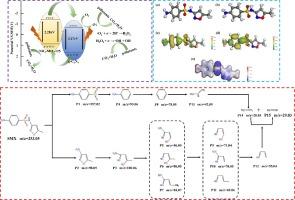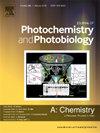Improved adsorption and charge transfer capacity by coupling g-C3N4 and NH2-MIL-125 for efficient degradation of sulfamethoxazole in water: Characterization, degradation efficiency, influence factors, and mechanism
IF 4.1
3区 化学
Q2 CHEMISTRY, PHYSICAL
Journal of Photochemistry and Photobiology A-chemistry
Pub Date : 2024-09-20
DOI:10.1016/j.jphotochem.2024.116040
引用次数: 0
Abstract
Photocatalysis is an advanced oxidation process that shows excellent promise in degrading organic pollutants present in water. However, electrons and holes tend to combine easily during the transfer process, and the adsorption capacity of single-phase photocatalytic materials is weak, resulting in a low degradation rate. Therefore, a new composite semiconductor photocatalyst g-C3N4/NH2-MIL-125 was constructed using a two-step solvothermal method. The morphology, elemental composition, structure, photoelectric properties, and photocatalytic activity of g-C3N4/NH2-MIL-125 were characterized. The photocatalytic degradation of Sulfamethoxazole (SMX) in water was also carried out. Results indicated that g-C3N4/NH2-MIL-125 had been synthesized successfully, and g-C3N4/NH2-MIL-125 had a broader photoresponse range, higher adsorption capacity, and higher separation efficiency of photogenerated carriers. When pH was 4.0 and catalyst dosage was 0.15 g/L, g-C3N4/NH2-MIL-125 showed the highest degradation rate for SMX. It was confirmed that the main active groups in SMX degradation were ![]() OH, h+, and
OH, h+, and ![]() O2−. 15 kinds of intermediates of SMX and the possible degradation pathways were identified by high-performance liquid chromatography-mass spectrometry and DFT calculation. Toxicity analysis revealed that the intermediate products have a lower developmental toxicity than SMX. This work demonstrated that g-C3N4/NH2-MIL-125 has great potential in eliminating antibiotics from water.
O2−. 15 kinds of intermediates of SMX and the possible degradation pathways were identified by high-performance liquid chromatography-mass spectrometry and DFT calculation. Toxicity analysis revealed that the intermediate products have a lower developmental toxicity than SMX. This work demonstrated that g-C3N4/NH2-MIL-125 has great potential in eliminating antibiotics from water.

通过耦合 g-C3N4 和 NH2-MIL-125 提高吸附和电荷转移能力,高效降解水中的磺胺甲噁唑:特性、降解效率、影响因素和机理
光催化是一种先进的氧化过程,在降解水中的有机污染物方面前景广阔。然而,电子和空穴在转移过程中容易结合,单相光催化材料的吸附能力较弱,导致降解率较低。因此,采用两步溶热法构建了一种新型复合半导体光催化剂 g-C3N4/NH2-MIL-125。研究人员对 g-C3N4/NH2-MIL-125 的形貌、元素组成、结构、光电特性和光催化活性进行了表征。此外,还对水中的磺胺甲噁唑(SMX)进行了光催化降解。结果表明,g-C3N4/NH2-MIL-125 已成功合成,且 g-C3N4/NH2-MIL-125 的光响应范围更广,吸附能力更强,光生载流子的分离效率更高。当 pH 值为 4.0、催化剂用量为 0.15 g/L 时,g-C3N4/NH2-MIL-125 对 SMX 的降解率最高。研究证实,降解 SMX 的主要活性基团是 OH、h+ 和 O2-。通过高效液相色谱-质谱法和 DFT 计算,确定了 SMX 的 15 种中间产物及可能的降解途径。毒性分析表明,这些中间产物的发育毒性低于 SMX。这项研究表明,g-C3N4/NH2-MIL-125 在消除水中的抗生素方面具有巨大潜力。
本文章由计算机程序翻译,如有差异,请以英文原文为准。
求助全文
约1分钟内获得全文
求助全文
来源期刊
CiteScore
7.90
自引率
7.00%
发文量
580
审稿时长
48 days
期刊介绍:
JPPA publishes the results of fundamental studies on all aspects of chemical phenomena induced by interactions between light and molecules/matter of all kinds.
All systems capable of being described at the molecular or integrated multimolecular level are appropriate for the journal. This includes all molecular chemical species as well as biomolecular, supramolecular, polymer and other macromolecular systems, as well as solid state photochemistry. In addition, the journal publishes studies of semiconductor and other photoactive organic and inorganic materials, photocatalysis (organic, inorganic, supramolecular and superconductor).
The scope includes condensed and gas phase photochemistry, as well as synchrotron radiation chemistry. A broad range of processes and techniques in photochemistry are covered such as light induced energy, electron and proton transfer; nonlinear photochemical behavior; mechanistic investigation of photochemical reactions and identification of the products of photochemical reactions; quantum yield determinations and measurements of rate constants for primary and secondary photochemical processes; steady-state and time-resolved emission, ultrafast spectroscopic methods, single molecule spectroscopy, time resolved X-ray diffraction, luminescence microscopy, and scattering spectroscopy applied to photochemistry. Papers in emerging and applied areas such as luminescent sensors, electroluminescence, solar energy conversion, atmospheric photochemistry, environmental remediation, and related photocatalytic chemistry are also welcome.

 求助内容:
求助内容: 应助结果提醒方式:
应助结果提醒方式:


